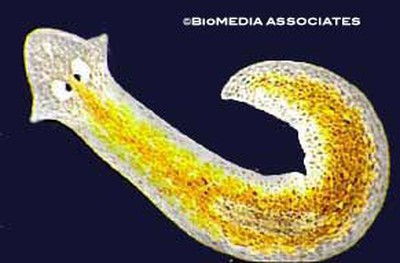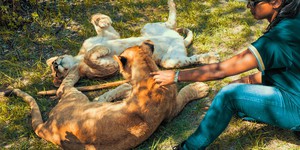Abstract
The human body has an impressive ability to heal itself after injury, but humans have nothing on planaria. Planaria have an amazing ability to regenerate. An entire animal can regenerate from just a fraction of the body! This project investigates the effect of magnetic field intensity on planarian regeneration.Summary
Andrew Olson, Ph.D., Science Buddies
Sources
This project idea is from:
- Formaker-Olivas, B., 2004. How Does the Intensity of a Magnetic Field Affect the Regeneration Rate of a Planarian? California State Science Fair Abstract. Retrieved August 2, 2006.

Objective
The goal of this project is to test the hypothesis that magnetic fields can increase the regeneration rate of planaria.
Introduction
Planaria are flatworms (platyhelminthes) that live in freshwater. They are simple organisms with three tissue layers (ectoderm, mesoderm, and endoderm) but no body cavity. They are remarkable for their ability to regenerate.
 Image Credit: BioMedia Associates / Copyrighted, used with permission.
Image Credit: BioMedia Associates / Copyrighted, used with permission.
Image courtesy BioMedia Associates.
Anatomical terms are used to describe the procedure for bisecting the planaria, so you will need to understand the following terms in italics. The head end of the planaria (with eyespots) is the anterior, and the tail end is the posterior. The dorsal surface is the one that is normally facing up (the "back" of the planaria). The ventral surface is the one that is normally facing down (the "front" of the planaria). The ventral surface contains the pharynx, through which planaria feed.
In this project you will be investigating whether strong magnetic fields have any effect on regeneration in planaria. See the Variations section for additional ideas for experiments on regeneration.
Terms and Concepts
To do this project, you should do research that enables you to understand the following terms and concepts:
- regeneration,
- anatomical terms:
- anterior,
- posterior,
- dorsal,
- ventral,
- pharynx,
- bisect.
Bibliography
- Wikipedia contributors, 2006. Planarium, Wikipedia, The Free Encyclopedia. Retrieved August 2, 2006.
- BioMedia Associates, 2006. Biology Classics: Planaria, BioMedia Associates. Retrieved August 2, 2006.
- K&J Magnetics, 2006. Neodymium Magnet Safety,. Retrieved August 2, 2006.
Materials and Equipment
To do this experiment you will need the following materials and equipment:
- at least 30 live planaria,
Notes on sources:- Planaria are available from online suppliers such as Carolina Biological catalog #132950. Because availability can vary with the season, be sure to check with them by phone first to make sure that the critters are in stock when you plan to do your project.
- If you want to try collecting planaria yourself, here are some tips from BioMedia Associates: "It's usually not difficult to find planarians. Shake pond weeds into a pan—flatworms will often be dislodged from their hiding places. Turn over stream rocks and look carefully at the rock surfaces." (BioMedia Associates, 2006) Once you've found them, here is a method for collecting them:
- "Put a small pellet of canned pet food in an old nylon stocking."
- "Secure this bag of attractant in the stream or pond bed overnight."
- "With any luck, in the morning you will find a collection of flatworms crawling over the bag." (BioMedia Associates, 2006)
- ice,
- scalpel or razor blade, available from an online supplier such as Carolina Biological catalog #625910.
- spring water or pond water,
- 6 shallow containers for planaria (e.g., 100 mm diameter Petri dishes),
- 6 pieces of steel sheet metal, each approx. 100 mm square,
- neodymium magnets of same outer dimensions, but increasing strength (3 values),
Notes on sources:- available online from K&J Magnetics, http://www.kjmagnetics.com;
- choose magnets with the same outside dimension, but with increasing surface field strength (e.g., part numbers D901, D91, D92);
- buy at least 21 magnets of the two lower strengths, and 42 of the highest strength (used for two groups of planaria).
Disclaimer: Science Buddies participates in affiliate programs with Home Science Tools, Amazon.com, Carolina Biological, and Jameco Electronics. Proceeds from the affiliate programs help support Science Buddies, a 501(c)(3) public charity, and keep our resources free for everyone. Our top priority is student learning. If you have any comments (positive or negative) related to purchases you've made for science projects from recommendations on our site, please let us know. Write to us at scibuddy@sciencebuddies.org.
Experimental Procedure
Safety Notes on Neodymium Magnets (K&J Magnetics, 2006).
"The neodymium magnets [used in this project] are extremely strong, and must be handled with care to avoid personal injury and damage to the magnets. Fingers and other body parts can get severely pinched between two attracting magnets. Neodymium magnets are brittle, and can peel, crack or shatter if allowed to slam together. Eye protection should be worn when handling these magnets, because shattering magnets can launch pieces at great speeds.
"The strong magnetic fields of neodymium magnets can also damage magnetic media such as floppy disks, credit cards, magnetic I.D. cards, cassette tapes, video tapes or other such devices. They can also damage televisions, VCRs, computer monitors and other CRT displays. Never place neodymium magnets near electronic appliances.
"Children should not be allowed to handle neodymium magnets as they can be dangerous. Small magnets pose a choking hazard and should never be swallowed or inserted into any part of the body.
"Never allow neodymium magnets near a person with a pacemaker or similar medical aid. The strong magnetic fields of the magnet can affect the operation of such devices.
"Neodymium magnets are brittle and prone to chipping and cracking. They do not take kindly to machining.
"Neodymium magnets will lose their magnetic properties if heated above 175° F (80° C).
"Neodymium magnets should never be burned, as burning them will create toxic fumes.
"Like any tool or toy, neodymium magnets can be fun and useful, but must always be treated with care."
- You will be dividing your planaria into 6 groups, according to the table. Groups 1–4 will be bisected (cut in half), and exposed to various magnetic field intensities (weakest = strength 1, strongest = strength 3). Groups 5 and 6 will be unoperated (whole animal) controls. Group 5 is not exposed to an increased magnetic field; group 6 is exposed to the strongest magnetic field (strength 3).
Group # Condition Magnet 1 bisected no magnets (plain sheet metal underneath) 2 bisected + magnets, strength 1 3 bisected + magnets, strength 2 4 bisected + magnets, strength 3 5 untreated no magnets (plain sheet metal underneath) 6 untreated + magnets, strength 3
- Label the sheet metal squares 1–6.
- Space the appropriate magnets evenly over a 100 mm circle (i.e., the size of the petri dish) on sheet metal squares 2, 3, 4, and 6 (see table, above). All of the magnets should be arranged with the same pole (either N or S) facing up. The sheet metal allows you to place the magnets closer together than you would on a non-magnetic surface, and also increases the magnetic field strength.
- Label the dishes 1–6 and place them on top of the correct sheet metal square.
- To bisect a planarian, use the following procedure:
- Place it on ice to immobilize and anesthetize the animal.
- Cut it in half with a scalpel or single-edged razor blade. Make the cut midway between the anterior (head) and posterior (tail) ends of the animal. Take care not to cut yourself!
- Immediately place the bisected pieces in the appropriate petri dish containing fresh spring or pond water.
- For this experiment, you will need to bisect 20 planaria (5 each for groups 1–4, assumes a total of 30 planaria available).
- Keep the petri dishes covered, and keep all of the dishes at the same temperature, in a place that is not exposed to bright light.
- Do not feed the planaria during the regeneration period. They are unlikely to feed during this time, so uneaten food will foul the water and the planaria will die.
- It's a good idea to do a 10% water change every few days. (If the water looks cloudy, change more often and/or change a larger fraction of the water.) Follow the same procedure for all six dishes. Do not use tap water (tap water is generally treated with clorine or chloramine, which would be toxic to the planaria). Use spring water or fresh pond water for the water changes.
- Observe the planaria daily. For each dish, measure the length of each of the segments and record the results. Also, record the lengths of the whole animals. Note any other observations you make.
- At the end of two weeks, summarize your results. What is the average amount of regeneration for each experimental group? Is there a systematic difference in regeneration rate with magnetic field strength?
- Calculate the average amount of regeneration for the head and tail sections separately. Is there any evidence for a difference in regeneration rates of the two segments?
Ask an Expert
Global Connections
The United Nations Sustainable Development Goals (UNSDGs) are a blueprint to achieve a better and more sustainable future for all.
Variations
- What happens if you bisect the planaria in half the other way (along the anterior-posterior axis, instead of across it)? Is the regeneration rate faster, slower, or the same?
- What happens if you cut the planaria into quarters? Which of the segments regenerates fastest?
- For a similar project with earthworms, see the Science Buddies project How Much Worm Is a Worm?.
- How do planaria orient to light? Cover half of the petri dish containing planaria with dark paper and expose the dish to light. Which side of the dish do the planaria prefer? Do you get the same result each time you repeat the experiment? What happens if you try this with bisected planaria? Do both segments react in the same way? Try this with a group of planaria bisected along the anterior-posterior axis and with a group bisected across the anterior-posterior axis.
Careers
If you like this project, you might enjoy exploring these related careers:








